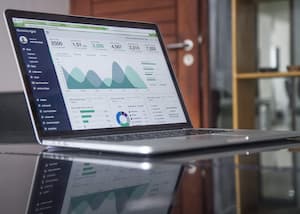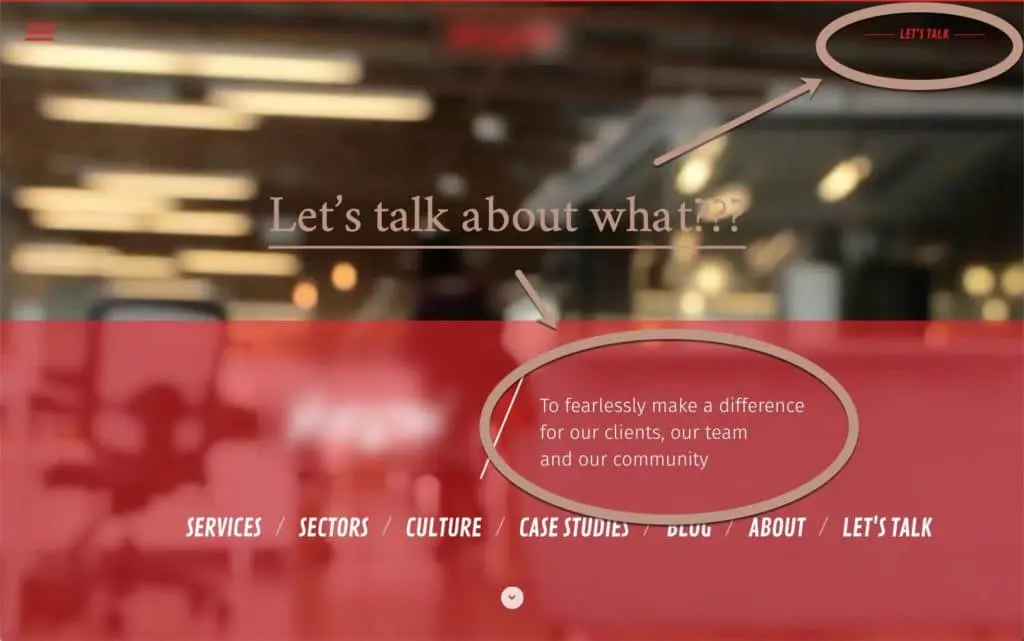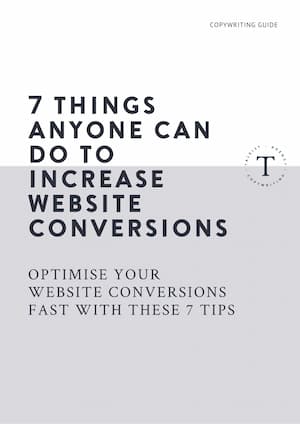How to increase your website conversion rate in 2025 — even if you have no web or design skills
If you tweak your website or landing page to follow the seven tips in this guide, you’ll improve your conversion rate. More than simply increasing your conversion rate, you’ll likely be in the top 5% of sites in your industry. That means you’ll be doing a better job for customers than 95% of the competition sites.
How do we know your conversion rates will be in the top 95% for your industry?
Because, as you’ll read below, we’ve seen it all.
We review clients’ websites to suggest content improvements to increase the conversion rates on their sales funnel.
Or as professional website copywriters, we write website content from scratch for new sites and product landing pages. And before we do any copywriting for a product or service, we comb competitor sites to look for what’s working.
Put those things together and it means we’re studying websites all the time. And in all that time, we’ve seen not a single site that was doing all seven of the conversion optimisers in the tips below.
That’s a massive opportunity for you to use these tips to get your value proposition in front of your customer, stand out and increase your conversions.
First, though, some definitions… (Unless you want to skip to the tips.)
What is the conversion rate on a website?

Your website conversion rate is the percentage of website visitors who complete an action you want them to take. Often, that action is buying something.
Buying something, however, is just one type of conversion. You might not have a product business. Or even if you do have a product business, you might measure more than sales. You might want your reader to email you or read more than one page on your website.
In those examples, your conversion rate would be the percentage of site visitors who emailed you or who read more than one page of your site.
Where do conversions happen?
A conversion could happen on any page of your site. It depends what you’re counting.
You might have a pop up that fires anywhere on the site. You might have a live chat option that displays on every page. Or you might have contact forms all over your website, from the homepage to the Contact Us page.
Don’t neglect your Contact Us page, by the way. It might be the most important page of your site when it comes to CRO. Check out our tips on how to write copy for a great Contact Us page.
How do I find the conversion rate for my website?
Your website conversion rate can be found by dividing goal completions (sales, email signups, etc.) by website views.
Google Analytics will track that percentage for you if you set up conversion goals.
What is conversion rate optimization?

Conversion rate optimization (CRO) is the art and science of improving the conversion rate of sites or landing pages.
CRO to increase conversions can involve making changes to any element of a site or page — from the homepage to a blog post.
The change could be visible — like rewriting copy, tweaking design, or swapping images or videos. Or it could be invisible, like making a page load faster.
You could improve your conversions by working on your value proposition. Not a completely new value proposition. You could add a free trial. You could offer free shipping. Free shipping wouldn’t change your core value proposition, but you could find that tweaking the edges makes all the difference.
You might limit yourself to writing content that doesn’t change the offer but explains it better. Or your new content might have a stronger call to action (CTA).
The conversion rate optimization process involves:
- Coming up with an idea for a change that might improve your conversions.
- Creating two versions of the site to run an A/B test. (An A/B test presents website users with one of two versions of the page. The page with more conversions wins.)
- The winning version is made permanent and the conversion rate optimization process begins again.
How do companies increase conversion rates?
Big companies typically increase conversion rates by making small changes, one at a time. They change a product price. Pick a new button colour or adjust the shade of the colour they’re already using. They change a headline. They reword a call to action from “learn more” to “discover more”.
A company with enough visitors can run dozens, if not hundreds, of these A/B tests at the same time. Imagine how many changes Amazon is running on the store at any time.
At the other end of the spectrum, a business with less traffic could wait months for meaningful results on a single test.
The argument for bold a/b tests

The solution for a small business or store is to be bolder with experimentation. Bold experimentation means doing more than changing a button or a word in a headline.
You could change your content from upbeat to content based on fear and loss aversion. You could combine that mood change with new product photography.
Making sweeping changes won’t give you pure data on what your target audience responds to. It could be the new money-back guarantee or refund policy. It could be a better-worded value proposition. It could be the fresh pop-ups.
You might never know exactly what moved the needle, but more of your potential customers will be doing what you want. And that’s what matters. Who cares whether it was the content, the product photography or the introduction of chat or better forms? Or all of the above?
(Actually, you care, but you can refine your a/b testing after the customers are rolling in.)
7 easy tips to improve your site or landing page conversion rate
Your sales funnel comes down to this. The customer is on your website. However you’ve found the prospective customers visiting your site, they’re here now. This is the moment of truth.
Follow these 7 tips to bend the data in your favour…
1. Conversion optimization tip — Opening with a crystal-clear positioning statement to increase your conversion rate
A clear positioning statement above the fold is our #1 conversion tip. That’s because we all spend so much time looking at websites and wondering, “That’s all very pretty, but what do you do?”
Your site visitors have Googled; they’ve seen there are a lot of companies to choose from. Here’s the good news. If Google is sending visitors to your site, your SEO copywriting is working.
Here’s the tougher news… You’ve got up to three seconds to look like a good answer or that customer will charge back to Google and click on one of the other results.
So what’s the cheapest, easiest thing you can do to instantly let a prospect know that they’re in the right place?
Spell out what you do. And don’t be cute. Be obvious.
Simple? Try this on the next 10 sites you visit; it doesn’t matter what they’re for:
How many sites assume you know what they do but don’t bother to tell you?
Like this:

“Let’s talk,” says the tagline at the top right. But do you have any idea what you might be talking to them about? Not from reading the vague little paragraph in the red band.
It’s great that they fearlessly make a difference for their customers, their team and even those of us who aren’t customers.
That fearlessness might be precisely the approach we’re looking for from someone who provides their service… if only we knew what that service was.
Could you even make an educated guess what they do for customers?
What you do isn’t information your reader should have to dig for.
Certainly, if you’re Apple, you don’t need to spell out what you do on your homepage. But if you’re not Apple and you’re not positioning yourself clearly above the fold on your homepage, try this quick fix on your site and you’ll see an immediate difference.
Here’s an example:

Okay, we’re biased, but there’s no doubt the visitor sent by Google to Taleist knows immediately that they’re on a copywriter’s website. Now they can ease their finger off the back button and read on (assuming it was a copywriter they were looking for).
2. Increase your conversion rate by writing an About Us page that isn’t (really) about you will improve your conversion rate
Your site’s About Us page is likely to be the second most popular page on your site. Why?
Your visitors are looking for someone to solve their problem. That problem might be a financial plan that will set them up for life or a Bluetooth speaker at the right price.
Whatever it is, customers won’t waste time on your site if they don’t trust you can solve the problem.
So the job of your About Us page is to give the reader confidence that you’re the company for the job. That means the page is only about your business on the surface.
This is the white lie that conversion experts and copywriters use to build trust with the reader. They call the page About Us, but they make it about the potential customer, more specifically the potential customer’s problem.
Your 100-year history is only relevant if your client might think you’re fly- by-night. Your love of free climbing is a perfect thing to mention if you sell ropes; it’s irrelevant if you’re an accountant — unless all your clients are free climbers.
There’s more about this in our guide to writing the perfect About Us page, but here’s a simple test to apply to your About Us page:
Does everything on your About Us page show a potential client that you’re the right company to solve their problem?
Get all these tips as an instant PDF download
Before you read on for more great tips, do you want all this advice as a PDF you can keep for reference? Register for a free Taleist account and we’ll add an instantly downloadable PDF to your library. Get the PDF.
3. Proof will explode your conversion rate
Here’s a surefire copywriting secret for writing a persuasive site:
Support every claim you make with proof.
You might have the actual “leading” product in your area, but that’s meaningless if every other store claims to be the leading brand. Find a way to prove your pre-eminence and your credibility will soar. And with soaring credibility comes a soaring conversion rate.
The most common type of proof you see on websites is social proof — generally, testimonials, reviews and case studies.
Social proof is powerful, but proof comes in dozens of forms, so it’s a shame to lean on only one. We go a through a list of 40 different types of proof in our first workshop with a new client. The list includes things like:
- Test results
- Accreditation
- Trust seals
- High-profile clients
- Media mentions
- Awards
Often the client will say no, no as we work through the list then we’ll hit gold, something that will make the client shine. The magic happens when that’s something they’ve never thought to mention before.
4. A lead magnet will improve your conversions in the longer term
Your site probably invites readers to telephone or email you. The problem is that only about 4% of your website visitors are ready to buy.
That 4% are likely the only ones who’ll pick up the phone or email you. The other 96% are on your site for research; they’re:
- Deciding whether they want what you offer at all or
- Deciding on a provider — do you have the product or service in the form they want it
What are you doing to persuade those 96% to identify themselves to you?
If your answer to what you’re doing for the 96% is “nothing”, you’re concentrating on getting only 4% of your visitors to let you know how there are.
That leaves you missing 24x more visitors, the ones researching before they become customers. Those researchers are nowhere as likely to pick up the phone or email as the buyers. Also, the researchers are people just like you who…
… Get distracted when online. The phone rings. A colleague drives by their desk. When that happens, they close or lose the site they’re looking at. Once that happens, there’s a good chance they won’t remember where they’ve been. They could end up with a competitor’s product only because they couldn’t find their way back to you.
A lead magnet is an offer you make to a website visitor in return for their email address. It’s usually something downloadable — like an infographic, a report, a list of seven things their website needs to convert…
When you have their email address, you can send them the information but, more importantly, you know who they are so you can follow up.
If you don’t have a lead magnet, you’ll have no way of getting hold of anyone who is visiting without being ready to buy. Except for what comes in tip #5…
Have you seen our popular online courses?
5. Remarketing pixels, another longer-term conversion rate optimisation tip
You might not get your website visitor’s email address, so you don’t know who they are. However, that doesn’t mean you can’t reach them again. All you need is a pixel.
A pixel is a piece of code from Facebook or Google.
- You put the code on your website.
- The code identifies your visitor to Google or Facebook.
Neither Google nor Facebook will reveal the visitor’s identity to you, but you can pay Google or Facebook to show advertising to anyone who visited your website.
If you pay Facebook, your future customer will see your ads when they’re browsing Facebook.
If you pay Google, your visitor could see your ad on any of the millions of sites in Google’s advertising network.
This is how you come to see ads from a company for days or weeks after visiting their website.
The advertising might be general, like a reminder of your brand. Alternatively, it might be highly specific — say, an ad for that fridge, restaurant or lawyer whose site you visited.
Pixelling then advertising to people who have visited your website is called “remarketing” or “retargeting”.
Plenty of people think remarketing is “creepy” — the idea that you’re following strangers around the internet (even if you don’t know who they are or how to find them yourself).
Other people argue that it’s helpful — someone who saw your site but didn’t get around to taking action is given a breadcrumb trail to find their way back.
If you don’t like the idea of remarketing now, you might like it in the future.
That’s why every site should have two pixels installed (one from Google and one from Facebook).
That way you’re building a list of “pixelled” visitors you can advertise to in the future.
When they do come back, they should still find you’re…
6. Showcasing features rather than listing benefits
Most sites concentrate on the features of their service or product — “fast”, “reliable”, “local”, “experienced”, etc. Firstly, many of those claims will be identical to those made by your competitors. More importantly, prospects don’t buy product features; they buy benefits.
A feature is a thing.
A benefit is what that thing does for you.
Feature: Your fridge keeps your food cold.
Benefit: Food lasts longer. Drinks are more refreshing.
This sounds incredibly simplistic. And it is… if your customers are already convinced they need what you’re selling.
You already know the general benefits of refrigeration so it would be stupid for Bing Lee to wax lyrical about how long your food will last in the fridge. (Unless that particular model keeps food longer than people are used to.)
But you’re not selling refrigerators, and the benefits of your service probably aren’t as well known. (Don’t assume your benefits are well understood just because you know what they are. You’ll be surprised by what people don’t know about what you do.)
Also, your customers aren’t giving you their full attention.
Put these things together — lack of knowledge and only giving you half their attention — and it doesn’t hurt to grease the conversion slide by connecting your features to the benefits to your clients.
If you’re local (and that’s important to clients), point out the benefits — easy to get to, on your way home, you understand the specific needs of the area…
If you’re reliable, spell out what that means — no waiting around, no callbacks for re-work.
Don’t assume your reader will take the time to connect all your features to the benefits to them. And speaking of assumptions…
7. Drop the jargon
Sometimes jargon is shorthand that speeds things up for people in the industry. More often, the jargon is baffling even to people inside the industry.
That’s why jargon is loved by people who don’t know what they’re talking about.
Your surgeon is an expert with a decade or more of training in science and technique. Would you think any less of them because they said “spreading” instead of “metastasising”?
If your clients are in your industry, jargon can be useful to show your insider status. However, even then you should use jargon only if you’re entirely confident:
- Your reader is fluent in industry jargon
- The jargon has precisely the same meaning everywhere
It’s worth remembering that the whole reason you have clients is probably because the client doesn’t know how to do what you do (even if they think they do).
Your customers are probably not insiders in your industry. They won’t think you look dumb if you make the effort to make yourself understandable; they’ll think you sound easy to work with.
If in doubt about whether your site is clear, there’s a simple test.
Give your copy to someone who knows roughly as much about what you do as a potential client might.
Ask them to read a page and — without any further input from you — tell you what that page means.
Ask them to tell you in their own words:
- What you do
- Why they should engage you instead of someone else
You might be surprised.
Put these things together — lack of knowledge and only giving you half their attention — and it doesn’t hurt to grease the conversion slide by connecting your features to the benefits to your customers.
If you’re local (and that’s important to clients), point out the benefits — easy to get to, on your way home, you understand the specific needs of the area… If you’re reliable, spell out what that means — no waiting around, no callbacks for re-work.
Don’t assume your reader will take the time to connect all your features to the benefits to them. And speaking of assumptions…
Going further
However obvious those seven qualities appear, they’re uncommon.
Does your website have all seven?
If it does, you can take your conversions to the next level by asking yourself these questions:
- Is this website written for my target customers’ level of knowledge of:
- My product or service?
- Why and when they might need me?
- Is my website structured to deal with all the reasons someone might not buy from me? When you’re selling in person, prospects will raise objections — too expensive, will you deliver on time, my last provider did this… With a website, you don’t have that feedback, so you have to anticipate it all in the copywriting.
- Does this website clearly address the question of why us and not the alternative? This is so central to conversions that before writing any website, we go through an exercise with the client to agree on the answer to that question.
- You can also go further — looking at user experience, design, typography and other elements of a good website.
A professional copywriter’s opinion of your website

If your website is getting the right visitors but they’re not converting, there’s only one possible answer: your site isn’t persuasive enough. We can help with website review by a professional copywriter.
This isn’t the same as asking a friend or associate to have a look. Where they might give your site a scan and come back with a personal opinion, we’ll comb your site through the eyes of your ideal client.
Alternatively, if you’re sending advertising traffic to a landing page, our copywriters will review your landing page to improve conversions.
And if you would just like to talk to a copywriter about how we can help you to optimize your conversion rate, please contact us.
Further reading on conversion rate optimization
If you want to get further into CRO, you should read Making Websites Win by Conversion Rate Experts.
Frequently asked questions about conversion optimization
Once you reach the point of recognising that your website should do something, it’s normal to have conversion optimization questions like…
What is a good conversion rate for a website?
Understandably, you want a number. But what makes a good conversion rate depends on your industry, the traffic you’re sending and the conversion you’re aiming for.
Let’s say you were offering full water bottles to lost hikers. Would you think a 50% conversion rate was good? No, if your product is like water for people with no choice, anything less than 100% would be a mystery.
So there is no universal “good” conversion rate. The only thing you can be 99% sure of is that your conversion rate could be better than it is.
How can you use Google Analytics to boost your conversion rates?
Google Analytics only records activity on your website; it can’t alter that activity. The difference Google Analytics can make is in giving you the data you need to know what’s working.
How to learn conversion rate optimization (CRO)?
You can study CRO, but do you need to? Unless you plan to become a professional, you don’t need to immerse yourself in the technical data. Much of conversion rate optimization is common sense.
Be honest with yourself:
- Is your site well designed? Does it reflect the standard of your business and product (and the standard consumers expect in your industry)?
- Is your site well written? Does the copywriting speak to the needs and inner desires of your potential customers? Does the copy describe your product accurately? Does it make your product attractive to your ideal customers? Do you provide the information ideal customers need for decision making?
- Are your calls to action clear? Do you spell out what potential customers need to do next?
If the answer to any of the above is no, then make changes and compare the results. Again, measuring the results is not complicated: do you move more product?
Is anything is missing from your site? What do you see on other sites that you could consider adding to your own site to increase conversions? Could you add:
- Free shipping?
- Live chat?
- Free trial?
- Blog posts about your products or services
Why is conversion tracking important?
Conversion tracking is important because it’s the only way to know if your website is working.
If any part of your sales funnel relies on your website, you want to track conversion data.
Maybe you don’t sell product from your website, but potential customers check you out online. Or your sales funnel involves email marketing. So you need to count how many potential customers give you their email address.
Sales funnels have more than one conversion rate
Every step in a sales funnel has a conversion rate.
What percentage of people click your Google ad? What percentage of those people download your PDF or engage in your live chat? How many of the email addresses that you capture turn into discovery calls? And so on.
If you increase conversions by a small amount at each stage, you can create massive change in the effectiveness of the sales funnel overall.
At a minimum, every step of your funnel involves content so you can experiment with the content in each stage of the sales funnel. Even tweaking headlines can have profound impacts on the data.
Website tracking and website review are the two activities that can be classified as conversion rate optimization. Review and monitor your website performance, track where visitors came from, find out which pages they viewed: these are among website tracking tasks.
What is the best call to action for a landing page?
The best call to action for a website landing page is one where the action is obvious. Discover more. Sign up. Buy now.
The best call to action for your specific landing page depends on your goal for the customer. And you want to choose your goal carefully because a good landing page has a single call to action (CTA).
You might repeat that call to action multiple times, but the whole point of a sales page is to focus customers on doing a single thing.
Bad landing pages invite the customer to click here there and everywhere, to go here to read more, to go there to sign up for your newsletter…
Remember, different pages have different goals. A homepage, for example, might have several goals — send the customer to a set of products, get them to read more about you, have them see new offers or sign up for emails.
What is the difference between page impressions and conversion rate?
Page impressions and conversion rates are two critical pieces of data.
Page impressions are how many times your pages are viewed. One visitor viewing a page once is one page impression. If that visitor reads the page, clicks to somewhere else then comes back to the first page, that’s two page impressions but still only one visitor.
Conversion rate is what percentage of those page impressions involve a customer taking an action you’re measuring.
What should be a priority — traffic or conversion rates?
This is a chicken and egg. Without traffic to your site, you can’t have conversions. But you can’t spend all your time concentrating on bringing in website traffic without considering how to convert those people.
So the answer is that traffic and conversions are both priorities. As you bring in more traffic with quality content and advertising, you can work on increasing the percentage of visits that turn into customers for your product.
One of the first things you could think about using your copy to get customers to stay longer. When your content is good, customers will stay around to read it. As they stay around drinking in useful content, you’re building a relationship with the reader.
And a prospective customer who has a relationship with you is more likely to do what you steer them to do. So to increase conversions, think about that relationship.
How important is better navigation to increase conversions?
You want visitors to flow through your site without making impulse mistakes (leaving the page before finishing or converting). That makes navigation a priority for the marketer.
Good website navigation is clear so customers are sure they’re on the right track as they browse your website. Navigation should clearly highlight options for conversion throughout the site, provide concise information about your brand, and make social proofing even easier with user reviews and testimonials from other satisfied customers.
How do reviews impact conversion rate?
Speaking of reviews and testimonials, social proof can be a major factor in convincing people to take action. Action comes from confidence about what’s on the other side. And people are more confident when they know that someone like them was happy with your product or service.
What is ecommerce conversion rate?
Ecommerce businesses are primarily concerned with one kind of conversion: sales. For that reason, ecommerce conversion rate is the percentage of visitors who buy something.
Where to start with getting your conversion rate up
The best place to start is somewhere. If you have traffic, you can definitely get more business from your site. You can definitely sell more products.
All you have to do is step back from your site, look at it as a prospect would. Are your offers clear? No, polish them. Are people reading the site but not contacting you? Look at your contact forms or checkout form. Are you asking for too much information? Could you reduce the number of fields in a form?
Any step you take to a/b test a change is the right step — it’s certainly better than no step. Growing your business and selling more products by tweaking your marketing is about making an infinite number of changes over time.
How do I write better content to improve my website conversions?
Content marketing and SEO will bring visitors to your website. Improved copywriting will convert more of those visitors to customers. And if those are skills you could do with sharpening, we have online courses for you…
